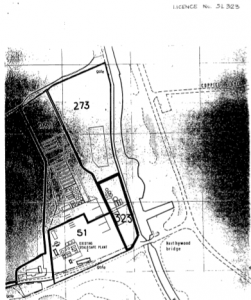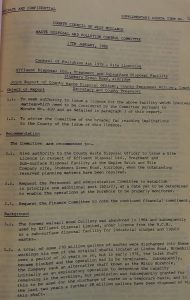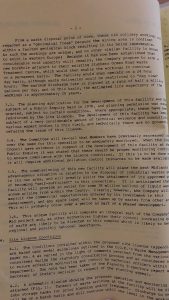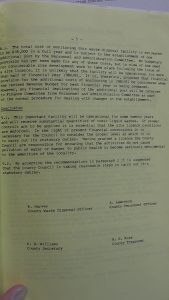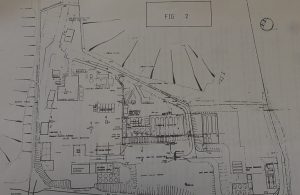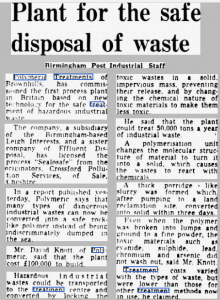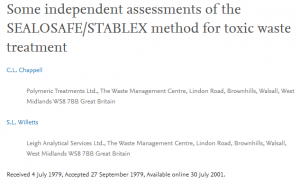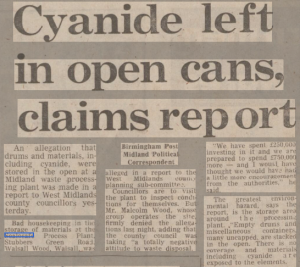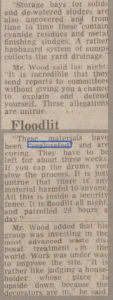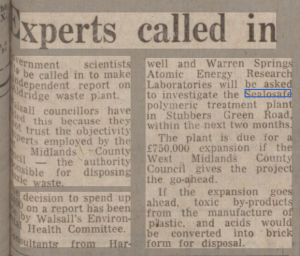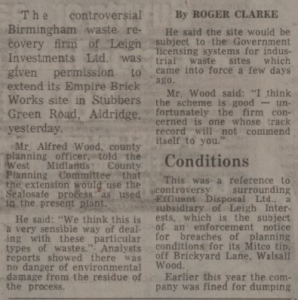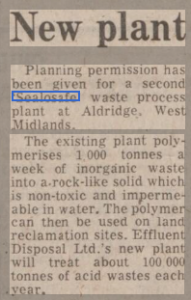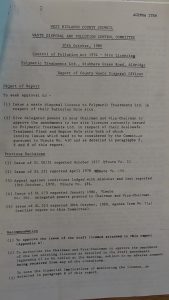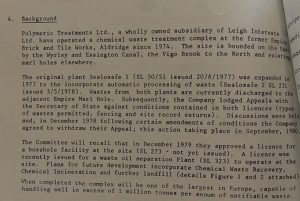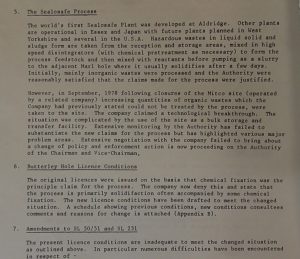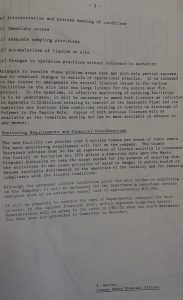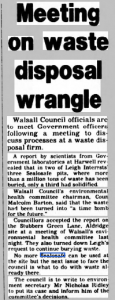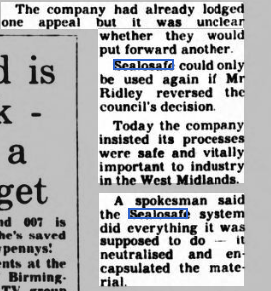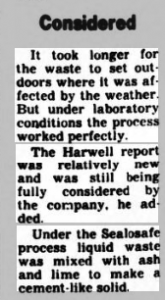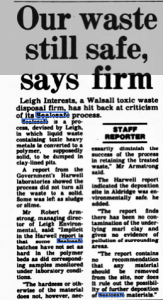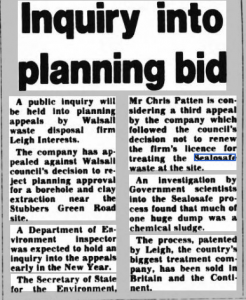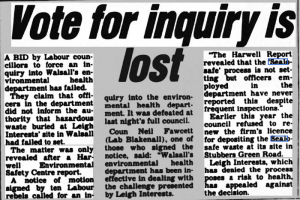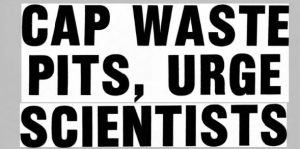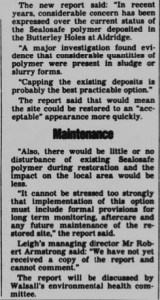This post contrasts the claims made by representatives of Leigh Environmental about their much heralded “sealosafe” process employed at their Walsall site, and the reviewed realities of the actual thing itself. There is little doubt that “sealosafe” represents one of the biggest misleading claims in waste disposal history, and that far from being the technology of the future, makes any site that ever used it far from “safe” for building anything on top of it.
It is worth at this point summarising the licences granted to Polymeric Treatments/Effluent Disposal/Leigh at this time for their expanding operations in Walsall. This is an extremely complicated web, and is quite difficult to fathom. But here goes….
The first sealosafe plant had seen licences SL50 and SL51 approved on 20/8/77.
(Licence SL51 would be reissued on 23/12/1983.)
Site Licence SL231 relating to The Empire Marl hole was issued on 3/3/1978.
Site Licence SL323 relating to the allied “Oil and Water treatment plant” was issued on 27/7/1983.
These licences and subsequent modifications can be summarised in the pdf below.
Site Licence SL273 relating to the subsurface treatment facility at The Empire works was considered at a meeting of The West Midlands County Council Waste Disposal and Pollution Control Committee dated 17/1/1980. Minutes of this meeting reveal that after approval was given for the Mitco borehole, (Licence SL226 ,see previous post) ,resumption of underground discharge in the previous 2 years had seen an extra 28 million gallons of waste disposed of into the workings. This 24/7 facility had been subject to a planning enquiry in 1978, and the licence itself only just being considered. It anticipated that 28 million gallons of waste per annum would be discharged underground.
The licence conditions for this contentious licence can be read below.
From an FOI request submitted to Walsall council, it appears that Leigh gave formal notice of surrender for this licence on 29th October 1992, along with the dormant SL46 Mitco licence.
Site licence SL324 relates to the Butterley Hole clay pits adjacent to the Empire Marl Hole, which Leigh also filled with “sealosafed” wastes.
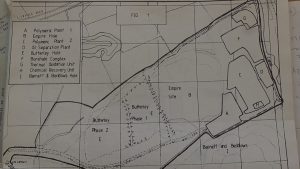
The Butterley Hole claypits, where Leigh’s disastrous product would be used to fill them in with toxic waste.
N.B This licence clearly sets out setting tests and a monitoring regime that was supposed to be followed about the types of wastes able to be used. This should be remembered when evaluating issues which subsequently came to light many years later.
An article from The Birmingham Post of 29th October 1974 makes many claims about sealosafe in a report compiled by the leigh subsidiary, but there is no evidence to support any of them. To summarise these
- The claims made about changing the chemical nature of the hazardous wastes to make them less toxic is the equivalent of turning water into wine.
- The claims made about the polymer being converted to a solid mass within three days.
- The claims made about the dangerous substances not washing out of the mixture.
As this post will demonstrate, all of these claims were later found to be false.
A later report published by a Messrs Chappell and Willets makes further claims about sealosafe in the abstract. “Stablex” was the product allegedly formed after polymerisation had occurred.
“Sealosafe is a chemical treatment process for converting hazardous wastes to a solid rock-like polymer. Wastes are accepted into the process plant in liquid, solid or semi solid form. From storage facilities, the wastes are fed into a chemical reactor together with reactants. The reaction occurs at ambient temperatures and there are no effluent discharges to atmosphere or sewer. The treated wastes are pumped in slurry form to a landfill disposal site where they harden into a solid within three days. The polymer is impervious to water. Its permeability coefficient is less than that of concrete. Even when the polymer is ground to a fine powder and immersed in ten times its weight of water, pollutants cannot be leached from it. The pollutants are fixed by crystal capture, a combination of chemical and physical bonding, thus preventing the threat of water pollution. The polymers have high strength, sufficient to permit their use in land reclamation schemes. In this article, background to the research and development of the process for the detoxification of hazardous industrial waste is described.”
It should be pointed out that this “independent” assessment was nothing of the sort. S.L Willets would publish a book entitled “The scientific management of hazardous wastes” published just 3 years later alongside C. Cope and W Fuller. Some 17.5 pages of this tomb are devoted to this crap product, where it reads like a pitching advertisement, despite the preface of the book claiming “Mention of any trade name, commercial product or service does not constitute an endorsement or recommendation” 😆
It can be seen as to whom Chappell and Willets actually worked for!
The following articles offer some interesting observations along the timeline of issued licences and the arguments behind their contentious determination.
Birmingham Daily Post 16th November 1976
This article highlights the incompetence and negligence of the Leigh/EDL/PTL set up and management. Bad house keeping of storing open drums of hazardous waste were reported in a paper to West Midlands county councillors. There is no doubt that open containers stored without cover could have leached out. Yet all we get from the pompous Malcolm Wood is more of the same denials and self important arrogance that he was well known for.
He claimed that the containers had been “sealosafed” and were curing- i.e hardening- yet the fact that they had been curing for some time perhaps started to ring alarm bells with the authorities that the scientific evidence behind sealsafe’s abilities was a fraud.
A post in 21st December 1976 Birmingham Daily Post revealed that the new West Mid sealosafe plant would be opened. It is again worth noting the false claims made by the company surrounding sealosafe in the article.
- That hazardous wastes such as cyanide could be “converted” chemically
- That it would set hard within two or three days
- That it was impermeable to water
- That it could be used to safely fill in quarries or other landfill sites
Birmingham Daily Post 15th April 1977.
It is reported in this article that Government scientists would be appointed by Walsall council because they did not trust the WMCC to deliver a realistic assessment. I have to say that this was a wise move , because the integrity and knowledge of people like Ken Harvey- the county waste disposal officer was an utter joke.
The Birmingham Daily Post 21st June 1977
This post details that the Empire brickworks site and the plan to mobilise the sealosafe 2 plant. The comments by planner Alfred Wood- no relation to Malcolm, are pure fantasy, but unfortunately the work of an authority which had no idea of what it was doing in managing hazardous waste.
The Birmingham Daily post 17th August 1977.
This piece almost appears as an advertisement and tells of how the Japanese had apparently fallen for the dubious product and the lie that it would set hard in a matter of hours.
The Birmingham Daily Post 12th September 1977.
This article reveals that planning permission had been approved for the second sealosafe process plant. The claimed amounts are interesting – the first plant supposedly treating 1000 tonnes a week, and the new plant claimed to treat 100,000 tonnes of acid wastes per year.
The myriad of licences and disputed conditions from Leigh’s activities obviously gave the West Midlands County council many headaches. It appears as the dawn of the new decade began, they were attempting to streamline all the various licences and conditions into a single one, but without much success it seems. 🙄
Two item agendas from the waste disposal and pollution control committee of 30th October 1980 are quite interesting.
From a report by Ken Harvey, perhaps the last thing he wrote before his death,
“5 Details of Appeal by Polymeric Treatments Ltd against conditions contained in a waste disposal licence.
Under Section 10 of the Control of Pollution Act , an applicant has a right of appeal against any of the conditions contained therein to the secretary of state. The committee will recall several previous instances where the waste disposal department has received notification from the Dept. of the environment that such an appeal has been made to the minister.
In July 1978 , Polymeric Treatments Ltd appealed to the secretary of state in respect of certain conditions contained in the site licence SL50/51 and SL231, breiefly-
(I) requirement to process water derived from site and “sealosafe” same (condition number 29).
(II) Requirement to supply records of depositions on site
(iii) Prohibition on site receiving any wastes which cannot be completely treated (condition No. 7)
(iv) Requirement to fence site. (Condition No. 3)
Detailed and protracted negotiations conducted with the company re in amendments to Conditions 7 on SL50/51 and condition 7 on SL231 and agreement on Condition 6 of the licence to submit coded site returns to ensure confidentiality . This agreement is subject to full details being made available to the Authority on request . Following this, in late 1978 the company agreed to withdraw their appeal and on 28th February , 1979 write to the Authority confirming this. However, it was not until 29th September 1980 that formal notification of the appeal was finally received by the authority.
In both licences, Condition 7 now reads “the wastes which shall be received at the facility shall be only those wastes which by previous sampling and analysis have been shown to be adequately treated by the equipment and process currently operating at the facility. Solid materials (e.g bricks ends , pieces of metal etc) which are not capable of being processed through the plant and equipment shall be segregated and disposed of in an authorised manner. Any other wastes shall only be received after agreement has been obtained from the Waste Disposal Authority. ” “
Another agenda item from the same date about licences includes a useful summary of Leigh’s activities to date, and the issuing of licences. It reveals that organic wastes, that were not supposed to be processed, were. Disputes about this viability between regulator and company were ongoing.
It is worth once again stating the SL324 BUTTERLEY HOLE Licence, which can be read in the PDF below.
The pooled comments regards licences SL50/51, SL231 AND SL324 can be read in the PDF below. It is clear from this that Walsall council had numerous concerns about these licences as they stood.
It is also clear that the financial cost to the authority and monitoring falling on the company were a pretty poor combination. The WMCC would hand over regulation to Walsall council’s “West Midlands Hazardous Waste Unit” in 1986, and it was undoubtedly a poison chalice of scientific ignorance and breath taking blasé attitude as to what Leigh were doing at their sprawling site that continued into the 1980’s.
At the end of the decade, and perhaps only as a result of the sterling work of local residents and campaigners who formed the Community Action Against Toxic Waste group (CAATW)(see next post to this one), that scrutiny fell on the absolute horror story that had been going on for over a decade.
Subsequent news articles tell the story of the demise of Leigh’s much heralded polymer.
Sandwell Evening Mail 19th June 1989
This report comments on a report commissioned by Walsall council involving Harwell laboratories into the sealosafe process. It also mentions the environmental health department considering the sealosafe waste licence. The article states as to how the council had withdrawn the licence after concerns about sealosafe the previous year due to the pits being “overfilled”. This was largely due to the work of the CAATW group.
It was already apparent, from a leak if you’ll excuse the pun 😉 that the sealosafe process had been found out in the report, and that the “solid” was in fact little more than a porridge slurry liquid.
Sandwell Evening Mail 20 June 1989
The following days paper revealed the revelation that in two of the pits containing over 1 million tonnes of buried waste ,(presumably Butterley hole), that only one third of the waste had set!
Councillor Barton described the scene as “a waste disposal time bomb for the future” -perhaps for Doctor Who to defuse 😛

The meeting rejected Leigh’s request to resume dumping waste using this fraudulent process.
The backtracking on their product is one of a company exposed and one in complete denial about its shit laboratory “science.”
The mixture at rattlechain lagoon was also supposed to “neutralise” the waste there using lime, or calcium phosphate, except it didn’t do that either. Oh, but it worked perfectly in the lab, beaker! 😀
Sandwell Evening Mail 27th June 1989
A full scale PR job was obviously now required on the part of this company, and so this is what appeared to be the case from this article. It is interesting to directly compare this one, with the phoney claims made in the first article of The Birmingham Post of 29th October 1974, some 15 years earlier.
This material, they had earlier claimed in other articles would practically revolutionise planning in the future, in that it would be “safe” to build new houses on top of within months, the material setting “solid within three days”.
The rest of the statements are just spin, from what was a disastrous report for this company and the “safety” of this useless slurry dross.
As the ENDS report from 1st January 1995 would later report about Harwell’s observations “According to Harwell, these were “indicative of a level of organics in the waste polymer mix which are unlikely to be compatible with generation of a polymer product with satisfactory physical and structural (as well as leaching) properties.”
The report backed up concerns about landslips and leachate getting into a water course, and nothing of the fantasy that the Leigh director spoke of.
Sandwell Evening Mail 27th June 1989
This is an updated and expanded story on the previous earlier edition, but it contains a very important statement, as regards Walsall council officers, as well as presumably Mr David O’Connor and his colleagues from The Walsall council run West Midlands Hazardous Waste Unit. O’Connor, had in fact left this organisation that very month, before the Harwell report had been published, for a position as “technical manager” at the very company he presumably had been “monitoring” for environmental compliance of the “sealosafe” process. I think that one just leaves to be left there. 🙄

“The condition of the polymer beds was known to environmental inspectors, who visited the site daily”.
Sandwell Evening Mail 13th October 1989
This article deals with planning and licence appeals made by the company against Walsall council. Incredibly, they would later pass all of them in 1995, though Leigh would by this time not use sealosafe again after this time. What role The Department of Environment had in knowledge about this fiasco is open to question, but it smells very, very bad indeed. The British Government had presumably been very happy for the collective shite of British industry to pour all of this into an open hole and forget about it. Would they really ever make a ruling which showed that this dire flawed and unsafe process was “unsafe” and the millions, if not billions of pounds needed to put it right? This Conservative Government at the time were the arse lickers of business’s like Leigh Environmental, and despised anything and anyone campaigning for environmental activism.
Sandwell Evening Mail 12th December 1989
This article is a very rare example of a local politician actually calling it like it was, and well done to Malcolm Barton for doing so at the time. He had called for an enquiry into the officers of Walsall council’s environmental health department, and why they had utterly failed to report on the failures of the “sealosafe” process which they knew about. Of course, a similar one should have been launched into The Hazardous waste unit, and its officers failures – also run by the useless Walsall council civil servants.
The motion was defeated, yet I would seriously question both (a) The scientific knowledge of these officers at this particular time, and (b) their professional integrity as public servants in failing to report on the failures of this company. Perhaps an inquiry would have also felt the collars of some local amateur politicians, too close to Leigh Interests business dealings? How was it that the clear monitoring as required and set out in the SL324 licence for sealosafe at Butterley hole had not been followed for all of those years?
Sandwell Evening Mail 4th July 1990
A further report from Harwell laboratories for Walsall council in the following year, showed that the best option for making safe the unsafe sealosafe was to cap it. This failure of course to deal with the disastrous method, which was a total failure in everything that it had claimed to do , was the “timebomb for the future” that Cllr Barton had spoken of. It was a failure of the Walsall council officers, a failure of The Hazardous Waste Unit, and of course, a failure of the useless idiot Ken Harvey and The West Midlands County council for ever allowing this cowboy waste disposal firm outfit the legitimacy of using clay holes for dumping toxic wastes.
How Walsall councillors could look themselves in the mirror after this failure , and NOT commission a report into their officers total failures, shows them up to be the disgrace that they were.
“SEALOSAFE” BREACHES THE TRADES DESCRIPTION ACT
Despite trying to brush off the damaging independent rubbishing of sealosafe and it’s fake properties, a further major blow for Leigh’s bogus product came when they were convicted for continuing to make false claims about it in a promotional video, fronted by at the time, the well known Tomorrow’s World presenter Peter McCann, (pictured at the head of this post). The Sandwell Evening Mail dated 7th December 1991 broke the news by stating that Walsall council trading standards had taken them to court under the Trades Description Act for exaggerating the properties of the polymer and its uses. The “ill advised, inaccurate and misleading” statements were condemned by the magistrate.
The same paper on 19th December 1991 reported that the company were fined £7,000 for the distorted false claims, as well as the £72,000 court costs for the seven breaches of the TDA. These were under section 14(1)(a), which makes it an offence knowingly to make a false statement about the nature of a service.
It is further revealed in an article dated 1st March 1992 from The END’s report that McCann had actually stood on a claimed solid block of sealosafe and
“….His footsteps are heard on the solid surface as he comments “I would hardly be standing here if it wasn’t entirely safe”.” 😳
There is also a little known story concerning a visit to the plant by Prince Phillip, The Duke of Edinburgh. He was presented with a pair of wellies by the company hirachy, and told to stand in sealosafe to test its alleged quick hardening properties. The Leigh bosses were made to look like idiots when Nick The Greek was left standing in porridge, with the sealosafe failing to set at all.
A further ENDS article concerning Butterley hole and sealosafe from 1st January 1995 reveals what had taken place.
“After encountering serious difficulties in attempting to recover drill samples from some of the deposits because they were so soft, Harwell concluded that they all had a high liquid content and a poor compressive strength. Some were highly permeable. Leachate from some areas also contained high levels of organic compounds. According to Harwell, these were “indicative of a level of organics in the waste polymer mix which are unlikely to be compatible with generation of a polymer product with satisfactory physical and structural (as well as leaching) properties.”
Leigh’s appeal against the refusal of a licence was narrowed down in 1991 to a part of Butterley Hole with about 100,000 cubic metres of void. The refusal was made on the grounds that the Sealosafe process had failed to produce polymer consistently to the relevant patents, and in order to prevent water pollution and danger to public health.”
Leigh made the claim on appeal that the quality of the polymer would be much improved, but contrast this bullshit with the earlier claims that they had made about a “technological breakthrough” when able to treat organic wastes. The claims were fantasy.
Two further academic independent reports pour cold water on sealosafe and its properties.
The first “CRITICAL REVIEW OF CEMENT -BASED STABILISATION/SOLIDIFICATION TECHNIQUES FOR THE DISPOSAL OF HAZARDOUS WASTES” ON TECHNIQUES CLARK (A) AND ASSOCIATES DEC 86
compares the product with an American rival called “chemfix” and looks at the chemistry behind the claims.
“Some of the most popular stabilisation/solidification techniques are those using a cement based technique to produce a solid monolithic mass. These techniques have been used for a number of years for heavy metal and certain inorganic wastes . However they are not as satisfactory for organic wastes since, unlike inorganic waste, there is little interaction between the organic material and the cementitious matrix, which results in soluble organic material and insoluble organic liquids being easily leached out by rainwater.”
This study also demonstrates that claims made about “impermeable” marl clay pits , like those at Butterley hole, can be affected by certain chemicals, particularly organic chemicals, and are not the “impermeable” cups that waste disposalists and their many apologist pocket geologist “experts” would like to claim that they are.
A second study reveals from the benefit of hindsight, the many flaws of sealosafe, and references the faults of leigh and their factory at Walsall.
Stabilisation/Solidification Treatment and Remediation: Proceedings …
Abir Al Tabbaa, Julia A Stegemann – 2005
Here are the key statements
Heavy metals and organic materials could leach out in high concentrations, in contrast to the false claims originally made about sealosafe.
This fiasco, which is what it remains, shows how science can be manipulated by certain companies to produce fanciful appealing cat bowl dishes, to which the political class, and their idiot civil servants lick their lips. If something seems like a quick cheap option, and too good to be true, then chances are it probably is just that. We are told as consumers to be weary of doorstep conmen wearing a cheap suit and a handsome smile. The problem is that people who wear white coats and have letters after their name, are no less trustworthy, yet they are more deceptive by their appearance.
The whole filling of these claypit holes, every clay pit hole ever dug out, with toxic waste was a terrible idea, and one certainly to this day which remains a “timebomb to the future”.

